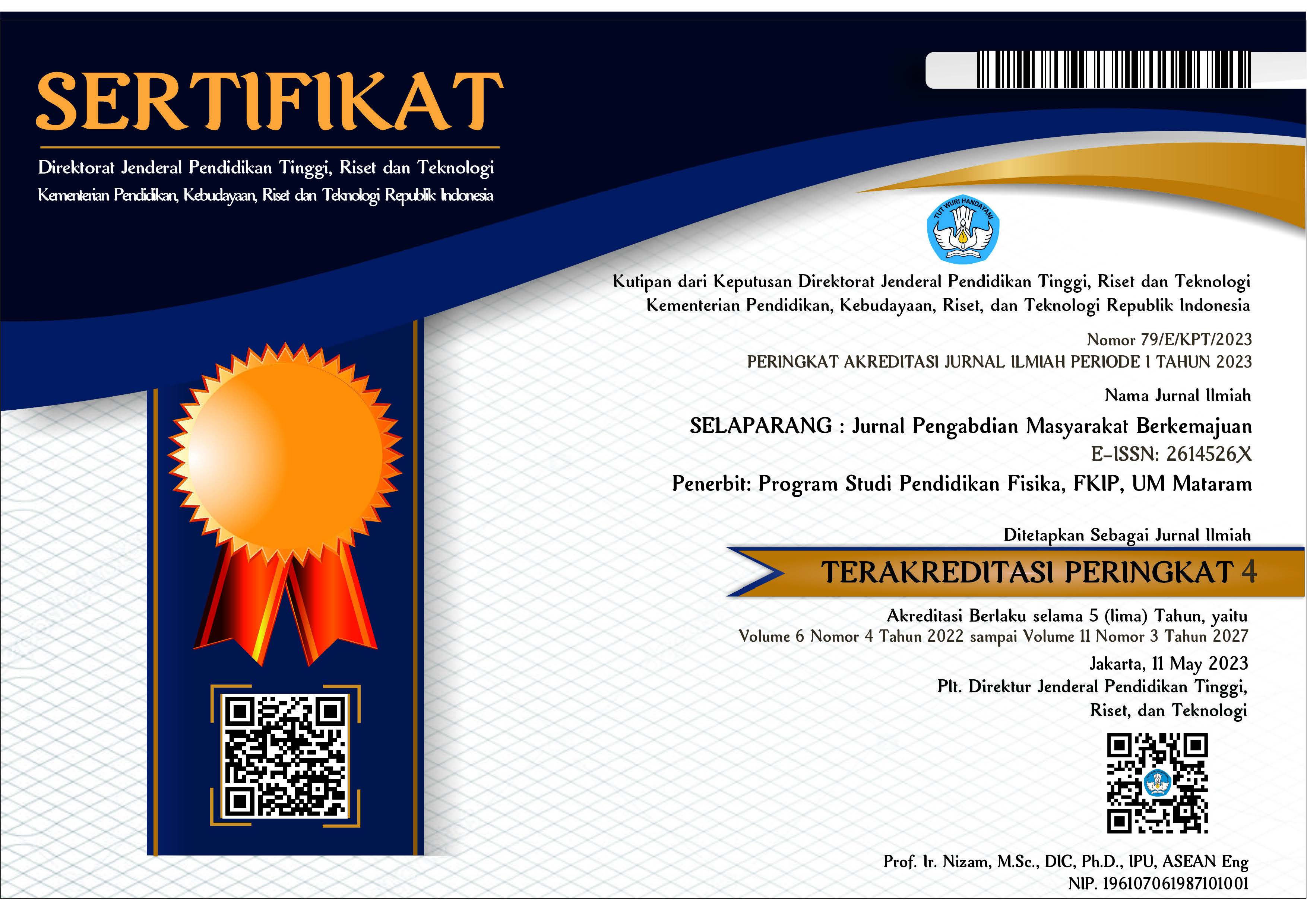PELATIHAN DAN PEMBUATAN ECOBRICK UNTUK MEMFASILITASI RUMAH BELAJAR SEKAR
Abstract
ABSTRAK
Pengabdian masyarakat ini ditujukan untuk memenuhi kebutuhan furnitur ecoclass, dengan memanfaatkan sampah yang ada di lingkungan mitra yaitu Rumah Belajar Sekar, Balikpapan. Untuk memenuhi kebutuhan furnitur ini, maka dilakukanlah sebuah pelatihan pembuatan ecobrick dalam bentuk webinar dan juga dibuatlah furnitur meja, kursi dan dinding dari ecobrick. Untuk mengetahui keberhasilan dari webinar yang telah dilaksanakan dengan jumlah peserta 16 orang, dilakukanlah pengisian questionnaire daring, sebelum dan sesudah webinar berlangsung. Dari hasil questionnaire dari webinar pelatihan pembuatan ecobrick yang telah dilakukan, didapatkan bahwa sebanyak 12 peserta dari total 16 peserta, sudah mengetahui apa itu ecobrick dan 9 diantaranya sudah mengetahui manfaat ecobrick, sebelum webinar berlangsung. Setelah webinar, dapat dilihat bahwa 16 peserta sudah mengetahui apa itu ecobrick dan apa manfaatnya. 16 peserta menyatakan tertarik untuk membuat ecobrick, namun hanya 14 yang tertarik untuk membuat furnitur ecobrick. 2 peserta mengungkapkan faktor penghambatnya adalah tidak ada waktu dan malas membuat. Dari pengabdian masyarakat ini dihasilkan 2 kursi, 1 meja dan juga 3 dinding ecobrick yang diletakkan di Rumah Belajar Sekar. Pembuatan ecobrick ini dapat menjawab permasalahan mitra untuk memenuhi kebutuhan furnitur dan juga menyelesaikan permasalahan untuk mengurangi sampah plastik.
Kata kunci: ecobrick; furnitur; pengelolaan sampah; plastik.
ABSTRACT
This community service is aimed to meet the needs of ecoclass’ furniture, by utilizing waste in the partner's environment, namely Rumah Belajar Sekar, Balikpapan. To fulfill this furniture need, an ecobrick making training was conducted in the form of a webinar. The team also made ecobrick as furniture like table, chairs and wall. To determine the results of the webinar that has been conducted with 16 participants, an online questionnaire was completed, before and after the webinar. From the questionnaire results, it was found that as many as 12 participants out of a total of 16 participants already knew what ecobrick was and 9 of them already knew the benefits of ecobricking, before the webinar took place. After the webinar, it can be seen that 16 participants already know what ecobricking was and what its benefits were. 16 participants expressed their interest in making ecobricks, but only 14 were interested in making ecobrick’s furniture. 2 participants revealed that the inhibiting factors were not having enough time and lazy to make. From this community service, 2 chairs, 1 table and 3 ecobrick walls were produced which were placed in the Rumah Belajar Sekar. Making this ecobrick can answer partner’s needs of furniture and also solve problems to reduce plastic waste.
Keywords: ecobrick; furniture; waste management; plastic
Keywords
Full Text:
PDFReferences
Aridhakahffi, I., & Ritonga, I. ramadhan. (2015). Distribusi mikroplastik pada sedimen di Muara Badak, Kabupaten Kutai Kartanegara. Depik, 4(3), 121–131.
Boerger, C. M., Lattin, G. L., Moore, S. L., & Moore, C. J. (2010). Plastic ingestion by planktivorous fishes in the North Pacific Central Gyre. Marine Pollution Bulletin, 60(12), 2275–2278.
Cauwenberghe, L. Van, Claessens, M., Vandegehuchte, M. B.,
Janssen, C., & Mees, J. (2013). Assessment of marine debris on the Belgian Continental Shelf. Marine Pollution Bulletin, 73(1).
Cole, M., Lindeque, P., Halsband, C., & Galloway, T. S. (2011). Microplastics as contaminants in the marine environment: A review. Marine Pollution Bulletin, 62, 2588–2597.
Firdaus, M., Trihadiningrum, Y., & Lestari, P. (2020). Microplastic pollution in the sediment of Jagir Estuary, Surabaya City, Indonesia. Marine Pollution Bulletin, 150.
Kementerian Lingkungan Hidup dan Kehutanan Republik Indonesia. (2018). Komposisi sampah di Balikpapan.
Khoironi, A., Hadiyanto, H., Anggoro, S., & Sudarno, S. (2020). Evaluation of polypropylene plastic degradation and microplastic identification in sediments at Tambak Lorok coastal area, Semarang, Indonesia. Marine Pollution Bulletin, 151.
The Global Ecobrick Alliance. (2018). What is ecobrick. https://www.ecobricks.org/what/
Wang, J., Liu, X., Li, Y., Powell, T., Wang, X., Wang, G., & Zhang, P. (2019). Microplastics as contaminants in the soil environment: A mini-review. Science of the Total Environment, 691, 848–857. https://doi.org/10.1016/j.scitotenv.2019.07.209
Yin, L., Chen, B., Xia, B., Shi, X., & Qu, K. (2018). Polystyrene microplastics alter the behavior, energy reserve and nutritional composition of marine jacopever (Sebastes schlegelii). Journal of Hazardous Materials, 360, 97–105.
DOI: https://doi.org/10.31764/jpmb.v4i1.3257
Refbacks
- There are currently no refbacks.

This work is licensed under a Creative Commons Attribution-ShareAlike 4.0 International License.
______________________________________________________
Jurnal Selaparang
p-ISSN 2614-5251 || e-ISSN 2614-526X
EDITORIAL OFFICE:



















